2015 TOYOTA AYGO flat tire
[x] Cancel search: flat tirePage 386 of 440
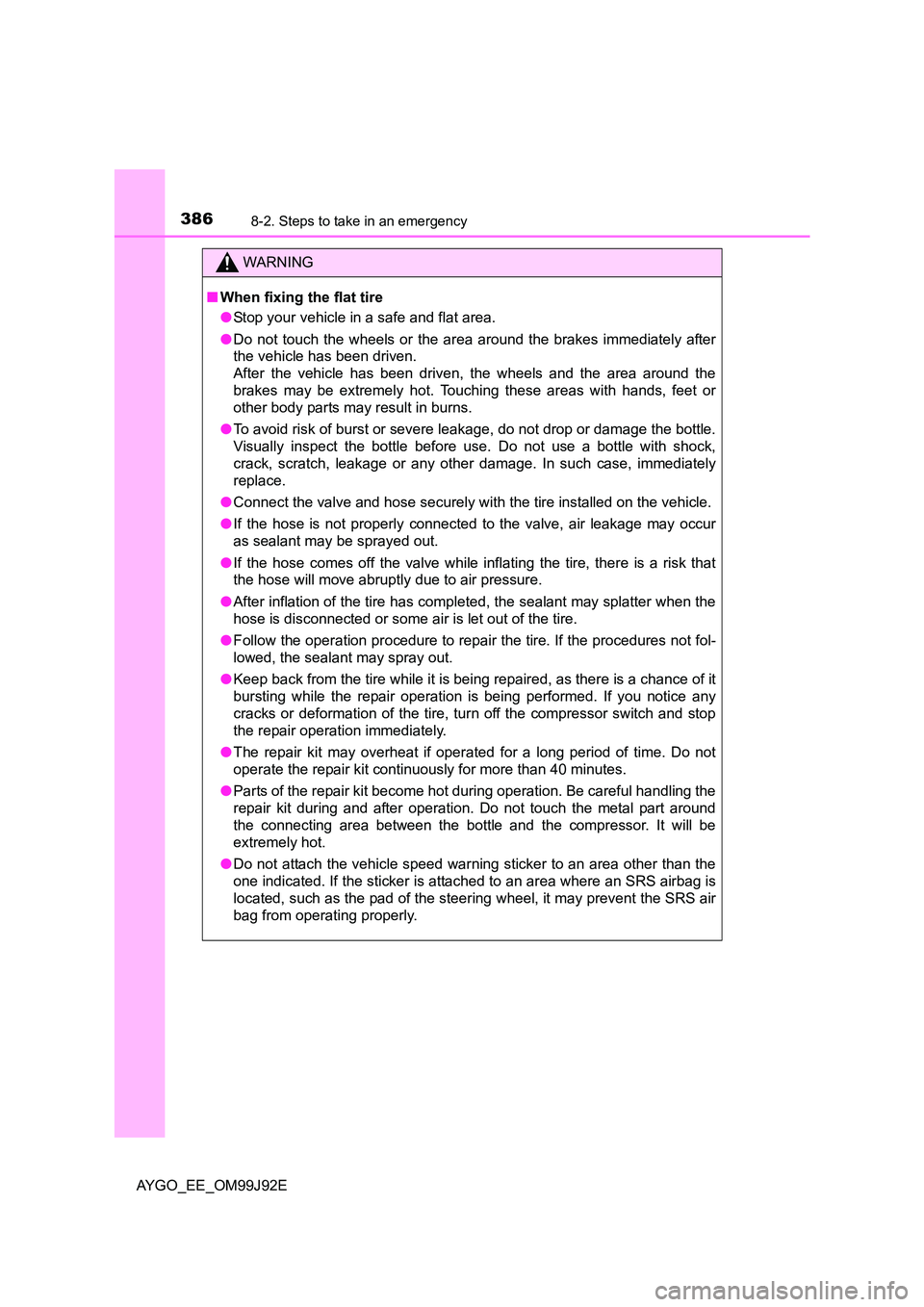
3868-2. Steps to take in an emergency
AYGO_EE_OM99J92E
WARNING
■ When fixing the flat tire
● Stop your vehicle in a safe and flat area.
● Do not touch the wheels or the area around the brakes immediately after
the vehicle has been driven.
After the vehicle has been driven, the wheels and the area around the
brakes may be extremely hot. Touching these areas with hands, feet or
other body parts may result in burns.
● To avoid risk of burst or severe leakage, do not drop or damage the bottle.
Visually inspect the bottle before use. Do not use a bottle with shock,
crack, scratch, leakage or any other damage. In such case, immediately
replace.
● Connect the valve and hose securely with the tire installed on the vehicle.
● If the hose is not properly connected to the valve, air leakage may occur
as sealant may be sprayed out.
● If the hose comes off the valve while inflating the tire, there is a risk that
the hose will move abruptly due to air pressure.
● After inflation of the tire has completed, the sealant may splatter when the
hose is disconnected or some air is let out of the tire.
● Follow the operation procedure to repair the tire. If the procedures not fol-
lowed, the sealant may spray out.
● Keep back from the tire while it is being repaired, as there is a chance of it
bursting while the repair operation is being performed. If you notice any
cracks or deformation of the tire, turn off the compressor switch and stop
the repair operation immediately.
● The repair kit may overheat if operated for a long period of time. Do not
operate the repair kit continuously for more than 40 minutes.
● Parts of the repair kit become hot during operation. Be careful handling the
repair kit during and after operation. Do not touch the metal part around
the connecting area between the bottle and the compressor. It will be
extremely hot.
● Do not attach the vehicle speed warning sticker to an area other than the
one indicated. If the sticker is attached to an area where an SRS airbag is
located, such as the pad of the steering wheel, it may prevent the SRS air
bag from operating properly.
Page 387 of 440
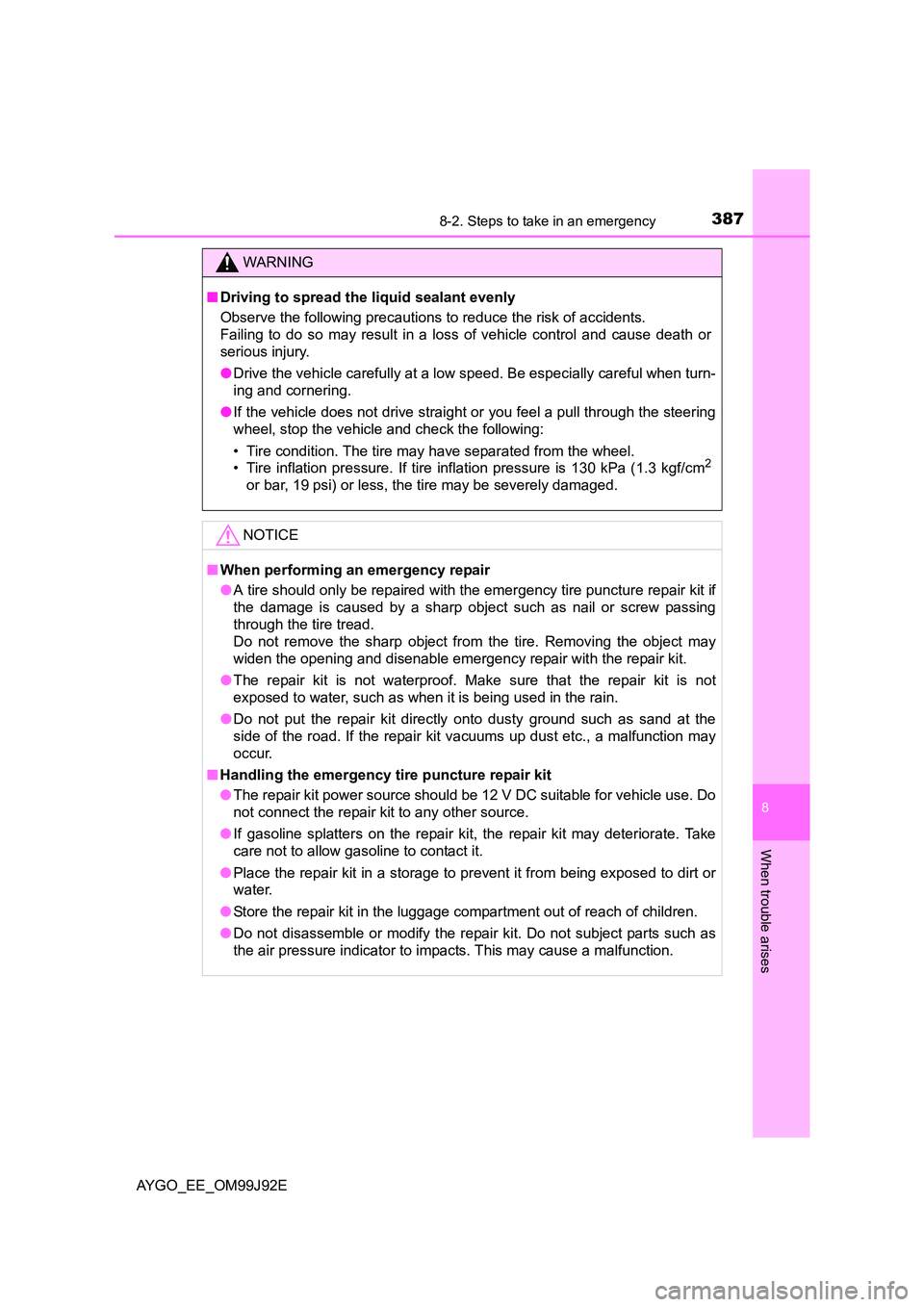
3878-2. Steps to take in an emergency
8
When trouble arises
AYGO_EE_OM99J92E
WARNING
■ Driving to spread the liquid sealant evenly
Observe the following precautions to reduce the risk of accidents.
Failing to do so may result in a loss of vehicle control and cause death or
serious injury.
● Drive the vehicle carefully at a low speed. Be especially careful when turn-
ing and cornering.
● If the vehicle does not drive straight or you feel a pull through the steering
wheel, stop the vehicle and check the following:
• Tire condition. The tire may have separated from the wheel.
• Tire inflation pressure. If tire inflation pressure is 130 kPa (1.3 kgf/cm2
or bar, 19 psi) or less, the tire may be severely damaged.
NOTICE
■ When performing an emergency repair
● A tire should only be repaired with the emergency tire puncture repair kit if
the damage is caused by a sharp object such as nail or screw passing
through the tire tread.
Do not remove the sharp object from the tire. Removing the object may
widen the opening and disenable emergency repair with the repair kit.
● The repair kit is not waterproof. Make sure that the repair kit is not
exposed to water, such as when it is being used in the rain.
● Do not put the repair kit directly onto dusty ground such as sand at the
side of the road. If the repair kit vacuums up dust etc., a malfunction may
occur.
■ Handling the emergency tire puncture repair kit
● The repair kit power source should be 12 V DC suitable for vehicle use. Do
not connect the repair kit to any other source.
● If gasoline splatters on the repair kit, the repair kit may deteriorate. Take
care not to allow gasoline to contact it.
● Place the repair kit in a storage to prevent it from being exposed to dirt or
water.
● Store the repair kit in the luggage compartment out of reach of children.
● Do not disassemble or modify the repair kit. Do not subject parts such as
the air pressure indicator to impacts. This may cause a malfunction.
Page 416 of 440
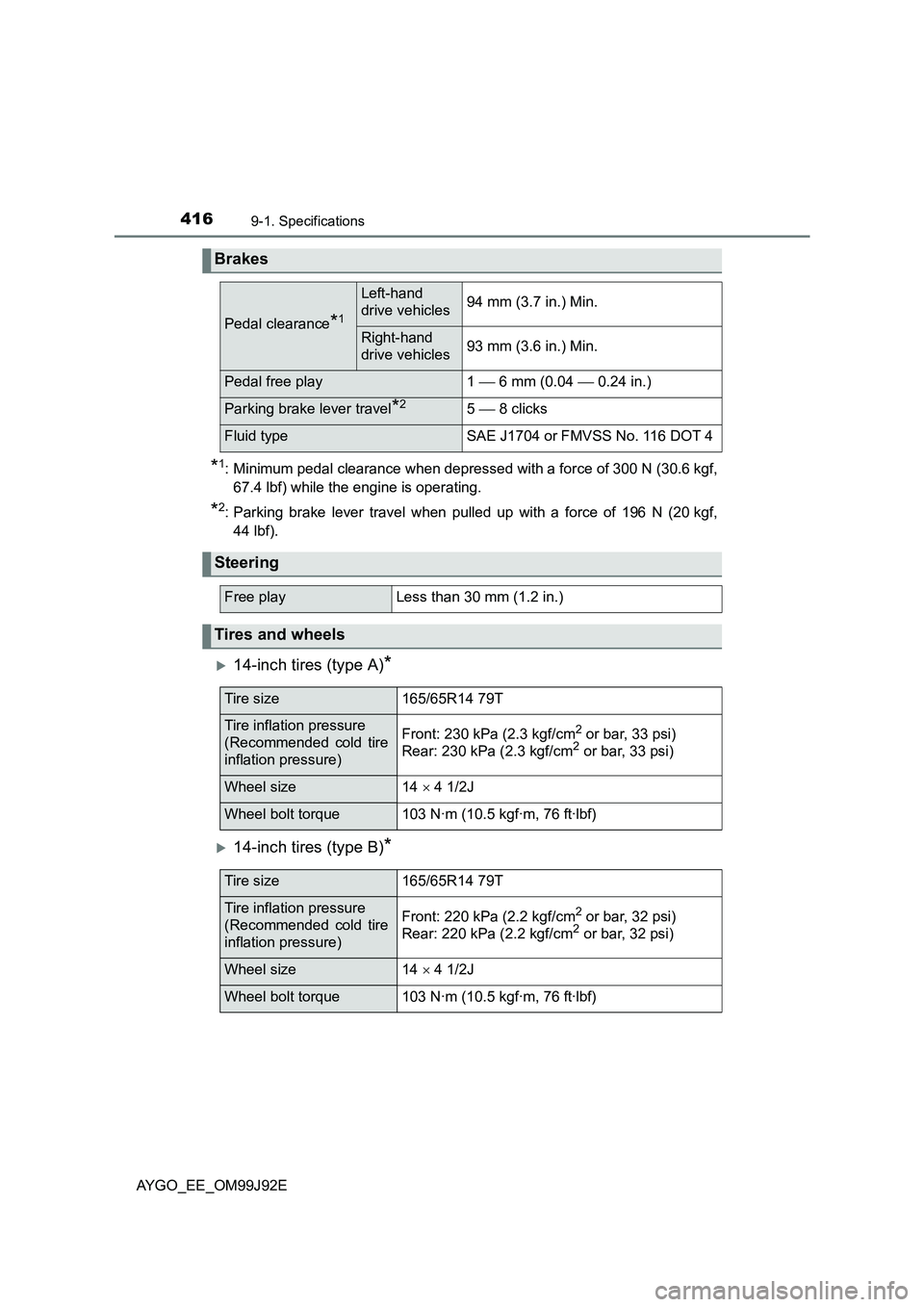
4169-1. Specifications
AYGO_EE_OM99J92E
*1: Minimum pedal clearance when depressed with a force of 300 N (30.6 kgf,
67.4 lbf) while the engine is operating.
*2: Parking brake lever travel when pulled up with a force of 196 N (20 kgf,
44 lbf).
�X14-inch tires (type A)*
�X14-inch tires (type B)*
Brakes
Pedal clearance*1
Left-hand
drive vehicles94 mm (3.7 in.) Min.
Right-hand
drive vehicles93 mm (3.6 in.) Min.
Pedal free play1 6 mm (0.04 0.24 in.)
Parking brake lever travel*25 8 clicks
Fluid typeSAE J1704 or FMVSS No. 116 DOT 4
Steering
Free playLess than 30 mm (1.2 in.)
Tires and wheels
Tire size165/65R14 79T
Tire inflation pressure
(Recommended cold tire
inflation pressure)
Front: 230 kPa (2.3 kgf/cm2 or bar, 33 psi)
Rear: 230 kPa (2.3 kgf/cm2 or bar, 33 psi)
Wheel size14 × 4 1/2J
Wheel bolt torque103 N·m (10.5 kgf·m, 76 ft·lbf)
Tire size165/65R14 79T
Tire inflation pressure
(Recommended cold tire
inflation pressure)
Front: 220 kPa (2.2 kgf/cm2 or bar, 32 psi)
Rear: 220 kPa (2.2 kgf/cm2 or bar, 32 psi)
Wheel size14 × 4 1/2J
Wheel bolt torque103 N·m (10.5 kgf·m, 76 ft·lbf)
Page 417 of 440
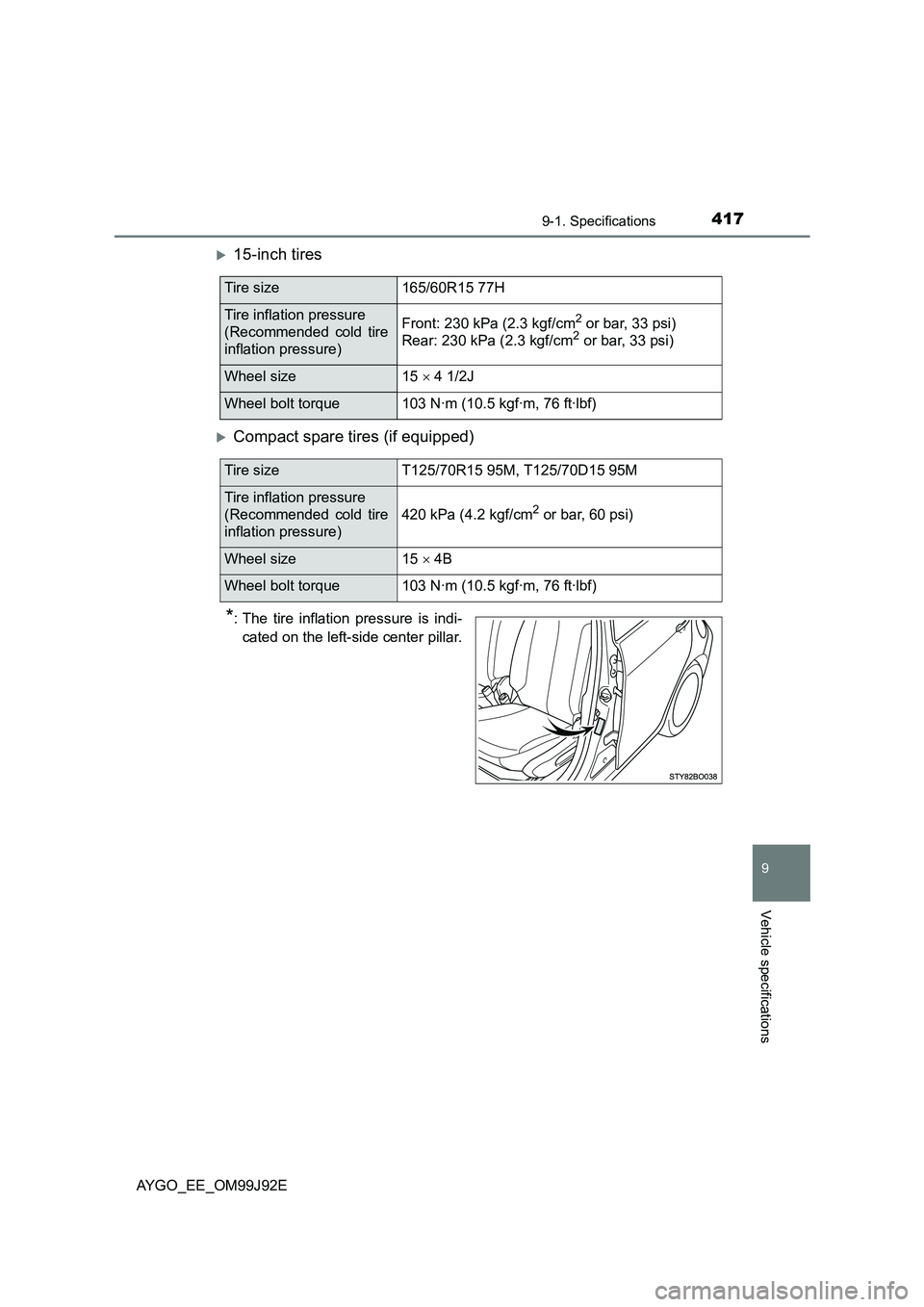
4179-1. Specifications
9
Vehicle specifications
AYGO_EE_OM99J92E
�X15-inch tires
�XCompact spare tires (if equipped)
*: The tire inflation pressure is indi-
cated on the left-side center pillar.
Tire size165/60R15 77H
Tire inflation pressure
(Recommended cold tire
inflation pressure)
Front: 230 kPa (2.3 kgf/cm2 or bar, 33 psi)
Rear: 230 kPa (2.3 kgf/cm2 or bar, 33 psi)
Wheel size15 × 4 1/2J
Wheel bolt torque103 N·m (10.5 kgf·m, 76 ft·lbf)
Tire sizeT125/70R15 95M, T125/70D15 95M
Tire inflation pressure
(Recommended cold tire
inflation pressure)
420 kPa (4.2 kgf/cm2 or bar, 60 psi)
Wheel size15 × 4B
Wheel bolt torque103 N·m (10.5 kgf·m, 76 ft·lbf)
Page 427 of 440
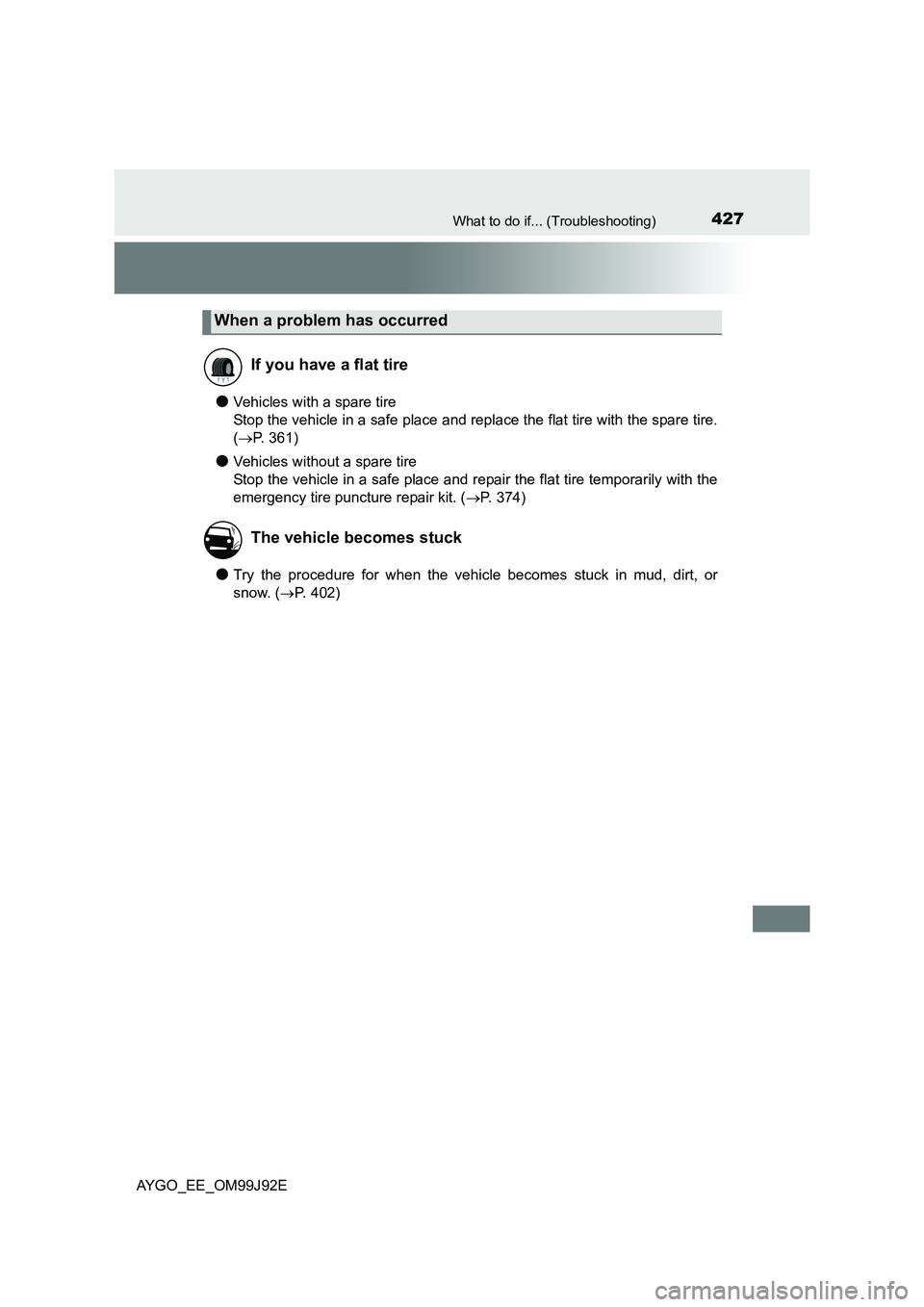
427What to do if... (Troubleshooting)
AYGO_EE_OM99J92E
●Vehicles with a spare tire
Stop the vehicle in a safe place and replace the flat tire with the spare tire.
( →P. 361)
●Vehicles without a spare tire
Stop the vehicle in a safe place and repair the flat tire temporarily with the
emergency tire puncture repair kit. ( →P. 374)
●Try the procedure for when the vehicle becomes stuck in mud, dirt, or
snow. ( →P. 402)
When a problem has occurred
If you have a flat tire
The vehicle becomes stuck
Page 430 of 440

430Alphabetical index
AYGO_EE_OM99J92E
Clock ......................................... 278
Condenser ................................ 303
Cooling system
Engine overheating ............... 398
Cup holders .............................. 272
Curtain shield airbags ............... 34
Customizable features ............ 421
Daytime running light
system .................................... 169
Defogger
Outside rear view
mirrors ........................ 258, 264
Rear window ................. 258, 264
Windshield .................... 258, 264
Dimension ................................ 406
Display
Multi-information display ......... 85
Trip information ....................... 85
Do-it-yourself maintenance .... 290
Doors
Back door .............................. 107
Door glasses ......................... 133
Door lock ....................... 102, 107
Open door warning buzzer.... 114
Open door warning light ........ 355
Outside rear view mirrors ...... 131
Rear door
child-protectors ................... 105
Side doors ............................. 102
Driving ...................................... 140
Break-in tips .......................... 142
Correct posture ....................... 28
Procedures............................ 140
Winter drive tips .................... 196
Electric Power Steering
(EPS)....................................... 191
Function ................................ 191
Warning light ......................... 354
Electronic key ............................ 92
Battery-saving function ......... 115
If the electronic key does not
operate properly ................. 391
Replacing the battery ............ 319
Emergency, in case of
If the electronic key does not
operate properly ................. 391
If the engine will not start ...... 388
If the shift lever cannot be
shifted ................................. 390
If the vehicle has discharged
battery ................................ 394
If the warning buzzer
sounds................................ 352
If the warning light
turns on .............................. 352
If you have a flat tire ..... 361, 374
If you lose your keys ............... 94
If you think something is
wrong.................................. 350
If your vehicle becomes
stuck ................................... 402
If your vehicle needs to be
towed .................................. 345
If your vehicle overheats ....... 398
Emergency brake signal ......... 191
Emergency flashers ................ 342
Emergency tire puncture
repair kit ................................. 374
D
E
Page 431 of 440

431Alphabetical index
AYGO_EE_OM99J92E
Engine
“ACC” position....................... 151
Accessory mode ................... 156
Compartment ........................ 296
Engine switch ................ 151, 154
Hood ..................................... 293
How to start
the engine................... 151, 154
If the engine will not start ...... 388
Ignition switch
(engine switch) ........... 151, 154
Overheating .......................... 398
Engine coolant ......................... 301
Capacity ................................ 413
Checking ............................... 301
Preparing and checking
before winter....................... 196
Engine coolant
temperature
warning light .................. 352, 353
Engine immobilizer system ...... 69
Engine oil.................................. 298
Capacity ................................ 408
Checking ............................... 298
Preparing and checking
before winter....................... 196
Engine switch
(ignition switch) ............. 151, 154
EPS (Electronic Power
Steering) ................................. 191
Function ................................ 191
Warning light ......................... 354
Flat tire
Vehicles with a spare tire ...... 361
Vehicles without
a spare tire ......................... 374
Floor mats .................................. 26
Fluid
Brake .................................... 416
Washer ................................. 307
Fog lights ................................. 171
Replacing light bulbs..... 333, 336
Switch ................................... 171
Wattage ................................ 418
Follow me home system ......... 169
Front position lights ................ 167
Light switch ........................... 167
Replacing light bulbs............. 339
Front seats ............................... 123
Adjustment ............................ 123
Cleaning................................ 285
Correct driving posture ........... 28
Seat heaters ......................... 268
Front turn signal lights ........... 165
Replacing light bulbs............. 333
Turn signal lever ................... 165
Wattage ................................ 418
Fuel ........................................... 408
Capacity ................................ 408
Fuel gauge .............................. 83
Fuel pump shut off system.... 351
Information ............................ 419
Refueling............................... 177
Type .............................. 177, 408
Warning light ......................... 355
Fuel filler door.......................... 179
Refueling............................... 177
Fuel pump shut off system ..... 351
Fuses ........................................ 322
F
Page 435 of 440

435Alphabetical index
AYGO_EE_OM99J92E
Seat belts .................................... 30
Child restraint system
installation............................. 58
Cleaning and maintaining
the seat belt ........................ 286
Emergency Locking
Retractor............................... 31
How to wear your seat belt ..... 30
How your child should wear
the seat belt .......................... 31
Pregnant women, proper
seat belt use ......................... 32
Reminder light and buzzer .... 355
Seat belt pretensioners ........... 31
SRS warning light ................. 354
Seat heaters ............................. 268
Seats ................................. 123, 125
Adjustment ............................ 123
Adjustment
precautions ................. 124, 126
Child seats/child restraint
system installation ................ 58
Cleaning ................................ 285
Folding down the rear
seatbacks ........................... 125
Head restraint ....................... 127
Properly sitting in the seat....... 28
Seat heaters.......................... 268
Sensor
Automatic headlight
system ................................ 169
Service reminder indicators ..... 78
Shift lever
If the shift lever cannot be
shifted ................................. 390
Manual transmission ............. 163
Multi-mode manual
transmission ....................... 159
Shift lock system ..................... 390
Shopping bag hooks ............... 275
Side airbags ............................... 34
Side mirrors ............................. 131
Adjusting and folding ............ 131
Side turn signal lights ............. 165
Replacing light bulbs............. 339
Turn signal lever ................... 165
Smart entry & start system ..... 113
Antenna location ................... 113
Entry functions .............. 103, 107
Starting the engine................ 154
Warning light ................. 355, 359
Snow tires ................................ 198
Spare tire .................................. 361
Inflation pressure .................. 416
Storage location .................... 362
Specifications .......................... 406
Speed limiter ............................ 181
Speedometer .............................. 83
Steering lock .................... 152, 157
Steering lock system
warning light ....................... 359
Steering wheel ......................... 128
Adjustment ............................ 128
Audio switches ...................... 202
Stop & Start system ................ 185
Stop/tail lights
Replacing light bulbs............. 336
Wattage ................................ 418
Storage feature ........................ 271
S
*: For vehicles with a multimedia system , refer to “Multimedia owner’s manual”.